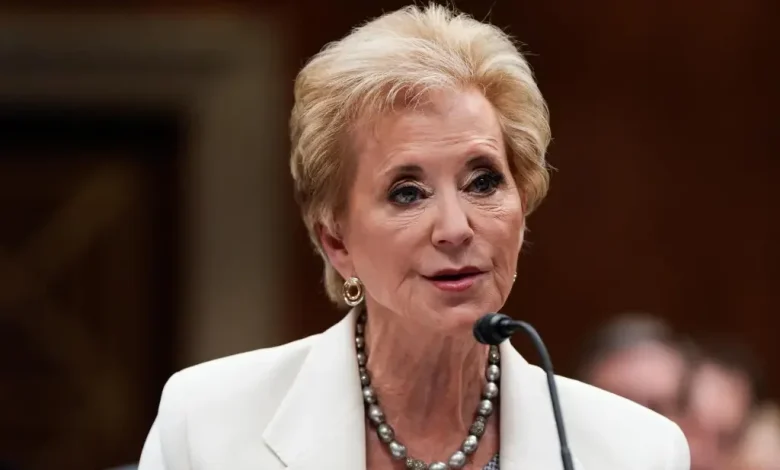Did the shutdown really prove that the Department of Education should be dismantled? Experts say it actually showed how much it’s needed.

Days after U.S. Secretary of Education Linda McMahon said the government shutdown proved how unnecessary the Department of Education is, the Trump administration announced plans to transition key department responsibilities to other government agencies — another step closer to eliminating the education department completely.
In an opinion piece for USA Today earlier this week, McMahon said the 43-day shutdown showed “every family how unnecessary” the department is to their children’s education.
“Students kept going to class. Teachers continued to get paid. There were no disruptions in sports seasons or bus routes,” McMahon said. “The shutdown proved an argument that conservatives have been making for 45 years: The U.S. Department of Education is mostly a pass-through for funds that are best managed by the states.”
The former CEO of wrestling giant WWE said now that the shutdown is over, the department is “emboldened” to fulfill President Donald Trump’s order to return education to the states. McMahon did not clarify that, as the Department of Education was established by Congress, eliminating the department entirely would require another act by Congress.
A few days later, McMahon announced six new agreements to transition existing education department responsibilities to the State Department, the Department of the Interior, the Department of Labor, and Health and Human Services. Those responsibilities include Title I federal funding for schools serving low-income students, higher education grants, foreign language education programs, college access programs and minority-serving institutions, among many more.
She said shutting down the education department wouldn’t mean the end of federal support for education, but merely the end of “a centralized bureaucracy micromanaging” what should be a state-led responsibility to improve service delivery and increase efficiency for school programs.
But education experts say history shows that McMahon’s argument is counterintuitive.
In fact, Patrick McGuinn, a professor of political science and education at Drew University, said the Department of Education was created in 1979 because the decentralized education policy up to that time had proved inefficient.
“One of the major arguments was that bringing all of these programs across all of these different federal bureaucratic departments (under one department) would actually increase efficiency, reduce red tape, reduce bureaucracy in education and actually empower states to more effectively use federal education dollars,” McGuinn said.
McGuinn said the department was created by Congress in 1979 because of the belief that the states lacked the political will or capacity to address large and persistent socioeconomic and racial achievement gaps among students, leading to dismal testing scores in U.S. schools. According to national testing data, scores among the lowest-performing students jumped in the 10 years following the creation of the education department.
Nora Gordon, an economist and professor of public policy at Georgetown University, said that under the U.S. Constitution, only the states have the authority to establish and regulate public schooling, but the federal government supports states through funding and enforcing civil rights laws.
While the feds are not required to do much beyond that, she said there are several reasons why the nation benefits from a federal role in education. For instance, she said, a broader perspective at the federal level is better suited to support research, development, grant funding and data collection for all students. Also, she said, only the federal government can move money across state lines, which is essential to redistributing tax dollars to poorer states that don’t have high property taxes — one of the main ways U.S. schools are funded.
Gordon said McMahon’s claim that the Department of Education is mostly a pass-through for funds best managed by the states is true — and, ironically, the main point of the department. It is also essential to ensuring those funds are being spent correctly and districts are complying with educational requirements, she said.
“Investing in education is important for the future of everyone who lives in this country because people cross state lines, and it matters for the future of democracy,” Gordon said.
While McMahon said the 43-day government shutdown proved that closing the education department would have no impact on the nation’s schools and students, McGuinn said it was a warning sign of what could be to come if the department’s key responsibilities are moved elsewhere.
During the 43-day shutdown, the education department furloughed nearly 87% of its 2,447 employees and issued layoff notices to hundreds more, including nearly all of the workers in the Department of Education’s special education division and many at the department’s Office of Civil Rights. The education department used to staff more than 4,000 employees, but slashed nearly half of its workforce in March under McMahon.
Enforcement of civil rights laws in schools was halted during the shutdown, leaving families on their own to navigate the complaint process and creating a backlog of more than 25,000 cases, educational advocates said.
The shutdown also caused chaos for several Head Start programs, a federal early childhood education program that serves more than half a million low-income children across the country. It left hundreds of programs at risk of closing due to a lack of federal funding. And even after the government reopened, nearly 9,000 children remained locked out of the program.
Students and families also saw increased food insecurity from the government’s funding cuts to the Supplemental Nutrition Assistance Program (SNAP), causing California to call on the Trump administration to provide additional flexibility to food stamps to ensure students had meals outside of school hours.
And while student aid programs, applications and loans were unaffected, application processing for student loan forgiveness plans was delayed, leaving hundreds of thousands of student borrowers in limbo due to the shutdown’s shuttering of department operations and furloughs of staff.
McGuinn said the transition away from the Department of Education, even if executed well, will cause problems — likely in the form of delayed funding and a loss of oversight and staff knowledge — all of which could cause less efficiency in the short term and greater inequity in the long term.
“I’m very concerned about the equity implications of all of this,” McGuinn said. “Both from the kind of turmoil that it’s going to cause in the short term and over the longer term if — as I fear — it sort of signals a desire to have the Department of Education and the federal government retreat from the pursuit of greater educational equity in the name of states’ rights and local control.”




